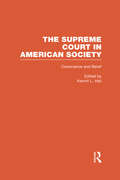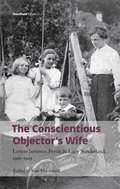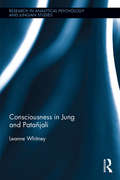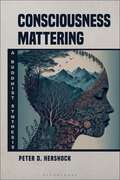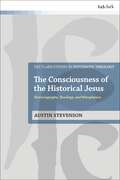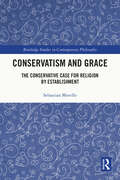- Table View
- List View
Conquest and Community: The Afterlife of Warrior Saint Ghazi Miyan
by Shahid AminFew topics in South Asian history are as contentious as that of the Turkic conquest of the Indian subcontinent that began in the twelfth century and led to a long period of Muslim rule. How is a historian supposed to write honestly about the bloody history of the conquest without falling into communitarian traps? Conquest and Community is Shahid Amin's answer. Covering more than eight hundred years of history, the book centers on the enduringly popular saint Ghazi Miyan, a youthful soldier of Islam whose shrines are found all over India. Amin details the warrior saint’s legendary exploits, then tracks the many ways he has been commemorated in the centuries since. The intriguing stories, ballads, and proverbs that grew up around Ghazi Miyan were, Amin shows, a way of domesticating the conquest—recognizing past conflicts and differences but nevertheless bringing diverse groups together into a community of devotees. What seems at first glance to be the story of one mythical figure becomes an allegory for the history of Hindu-Muslim relations over an astonishingly long period of time, and a timely contribution to current political and historical debates.
Conquest and Community: The Afterlife of Warrior Saint Ghazi Miyan
by Shahid AminFew topics in South Asian history are as contentious as that of the Turkic conquest of the Indian subcontinent that began in the twelfth century and led to a long period of Muslim rule. How is a historian supposed to write honestly about the bloody history of the conquest without falling into communitarian traps? Conquest and Community is Shahid Amin's answer. Covering more than eight hundred years of history, the book centers on the enduringly popular saint Ghazi Miyan, a youthful soldier of Islam whose shrines are found all over India. Amin details the warrior saint’s legendary exploits, then tracks the many ways he has been commemorated in the centuries since. The intriguing stories, ballads, and proverbs that grew up around Ghazi Miyan were, Amin shows, a way of domesticating the conquest—recognizing past conflicts and differences but nevertheless bringing diverse groups together into a community of devotees. What seems at first glance to be the story of one mythical figure becomes an allegory for the history of Hindu-Muslim relations over an astonishingly long period of time, and a timely contribution to current political and historical debates.
Conquest of Violence: The Gandhian Philosophy of Conflict. With a new epilogue by the author (PDF)
by Joan Valerie BondurantWhen Mahatma Gandhi died in 1948 by an assassin's bullet, the most potent legacy he left to the world was the technique of satyagraha (literally, holding on to the Truth). His "experiments with Truth" were far from complete at the time of his death, but he had developed a new technique for effecting social and political change through the constructive conduct of conflict: Gandhian satyagraha had become eminently more than "passive resistance" or "civil disobedience." By relating what Gandhi said to what he did and by examining instances of satyagraha led by others, this book abstracts from the Indian experiments those essential elements that constitute the Gandhian technique. It explores, in terms familiar to the Western reader, its distinguishing characteristics and its far-reaching implications for social and political philosophy.
Conquest of Violence: The Gandhian Philosophy of Conflict. With a new epilogue by the author
by Joan Valerie BondurantWhen Mahatma Gandhi died in 1948 by an assassin's bullet, the most potent legacy he left to the world was the technique of satyagraha (literally, holding on to the Truth). His "experiments with Truth" were far from complete at the time of his death, but he had developed a new technique for effecting social and political change through the constructive conduct of conflict: Gandhian satyagraha had become eminently more than "passive resistance" or "civil disobedience." By relating what Gandhi said to what he did and by examining instances of satyagraha led by others, this book abstracts from the Indian experiments those essential elements that constitute the Gandhian technique. It explores, in terms familiar to the Western reader, its distinguishing characteristics and its far-reaching implications for social and political philosophy.
Conscience and Belief: The Supreme Court in American Society
by Kermit L. HallAvailable as a single volume or as part of the 10 volume set Supreme Court in American Society
Conscience and Belief: The Supreme Court in American Society (The\supreme Court In American Society Ser. #Vol. 8)
by Kermit L. HallAvailable as a single volume or as part of the 10 volume set Supreme Court in American Society
Conscience and Calling: Ethical Reflections on Catholic Women's Church Vocations
by Anne E. PatrickThis volume probes the meaning and ethical implications of the powerful symbol of vocation from the vantage of contemporary Catholic women, with particular attention to the experiences of women religious. Intended as a follow-up to Liberating Conscience: Feminist Explorations in Catholic Moral Theology, the new book will benefit many readers, including Catholic leaders, laity, and religious, as well as persons interested in Christian ethics and American religious history more generally. The work treats twentieth-century history and more recent developments, including tensions between the Vatican and progressive Catholics, the development of lay ministries, and the movement to ordain women deacons, priests, and bishops.
Conscience and Calling: Ethical Reflections on Catholic Women's Church Vocations
by Anne E. PatrickThis volume probes the meaning and ethical implications of the powerful symbol of vocation from the vantage of contemporary Catholic women, with particular attention to the experiences of women religious. Intended as a follow-up to Liberating Conscience: Feminist Explorations in Catholic Moral Theology, the new book will benefit many readers, including Catholic leaders, laity, and religious, as well as persons interested in Christian ethics and American religious history more generally. The work treats twentieth-century history and more recent developments, including tensions between the Vatican and progressive Catholics, the development of lay ministries, and the movement to ordain women deacons, priests, and bishops.
Conscience and Conversion: Religious Liberty in Post-Revolutionary France
by Thomas KselmanReligious liberty is usually examined within a larger discussion of church-state relations, but Thomas Kselman looks at several individuals in Restoration France whose high-profile conversions fascinated their contemporaries. Exploring their reasons and the repercussions they faced, Kselman demonstrates how this expanded sense of liberty informs our secular age.
The Conscience of the Rich (Strangers and Brothers #3)
by C. P. SnowIn this, the quietly powerful third novel in C. P. Snow’s Strangers and Brothers sequence, Lewis Eliot narrates the world of the great Anglo-Jewish banking dynasties between the two World Wars.Drawn into the fold of one such family by his friendship with the son and heir, Charles March, Lewis observes the impact of the changing world on their closed and privileged circle. The forces of communism and fascism, the rise of Hitler and steady progress of the nation towards war are interwoven with domestic crises; Charles defects from his promising legal career in favour of medicine, his sister Kathrine falls in love with a gentile, and his uncle becomes incriminated in shady political deal-making, and the family slowly falls apart.Told with the mixture of humanity and exactitude that is uniquely Snow’s, The Conscience of the Rich painstakingly documents the swansong of the British upper-classes.A meticulous study of the public issues and private problems of post-war Britain, C. P. Snow’s Strangers and Brothers sequence is a towering achievement that stands alongside Anthony Powell’s A Dance to the Music of Time as one of the great romans-fleuves of the twentieth century.Praise for the Strangers and Brothers sequence“Together, the sequence presents a vivid portrait of British academic, political and public life. Snow was that rare thing, a scientist and novelist.” Jeffrey Archer, Guardian“Balzacian masterpieces of the age” Philip Hensher, Telegraph“Through [the Strangers and Brothers sequence] as in no other work in our time we have explored the inner life of the new classless class that is the 20th century Establishment” New York Times“A very considerable achievement … It brings into the novel themes and locales never seen before (except perhaps in Trollope).” Anthony Burgess
Consciences and the Reformation: Scruples over Oaths and Confessions in the Era of Calvin and His Contemporaries (OXFORD STU IN HISTORICAL THEOLOGY SERIES)
by Timothy R. ScheuersThis book examines the contentious relationship between oath-taking, confessional subscription, and the binding of the conscience in reforms led by John Calvin. Calvin and his closest Reformed colleagues routinely distinguished what they believed were impious rules and constitutions in the Roman Church--human traditions claiming to bind the consciences of the faithful by putting them in fear of losing their salvation--and legitimate church observances, such as oaths and formal subscription to Reformed confessional standards. Doctrinal and moral reform in the cities became difficult, however, when friends and foes alike accused Calvin and his partners of burdening consciences with extra-Scriptural statements of faith composed by human authorities--a claim that, if true, would necessarily shape our assessment of the integrity of Calvin's Reformation. In light of these conflicts, author Timothy R. Scheuers offers a close reading of the texts and controversies surrounding Calvin's struggle for reform. In particular, he shows how they reveal the unique challenges Calvin and his colleagues encountered as they attempted to employ oath-swearing and formal confession of faith in order to consolidate the reformation of church and society. This book demonstrates how oaths and vows were used to shape confessional identity, secure social order, forge community, and promote faithfulness in public and private contracts. It also illustrates the complex and difficult task of protecting the individual conscience as Calvin sought to bring his new take on Christian freedom into Reformed communities.
Consciences and the Reformation: Scruples over Oaths and Confessions in the Era of Calvin and His Contemporaries (OXFORD STU IN HISTORICAL THEOLOGY SERIES)
by Timothy R. ScheuersThis book examines the contentious relationship between oath-taking, confessional subscription, and the binding of the conscience in reforms led by John Calvin. Calvin and his closest Reformed colleagues routinely distinguished what they believed were impious rules and constitutions in the Roman Church--human traditions claiming to bind the consciences of the faithful by putting them in fear of losing their salvation--and legitimate church observances, such as oaths and formal subscription to Reformed confessional standards. Doctrinal and moral reform in the cities became difficult, however, when friends and foes alike accused Calvin and his partners of burdening consciences with extra-Scriptural statements of faith composed by human authorities--a claim that, if true, would necessarily shape our assessment of the integrity of Calvin's Reformation. In light of these conflicts, author Timothy R. Scheuers offers a close reading of the texts and controversies surrounding Calvin's struggle for reform. In particular, he shows how they reveal the unique challenges Calvin and his colleagues encountered as they attempted to employ oath-swearing and formal confession of faith in order to consolidate the reformation of church and society. This book demonstrates how oaths and vows were used to shape confessional identity, secure social order, forge community, and promote faithfulness in public and private contracts. It also illustrates the complex and difficult task of protecting the individual conscience as Calvin sought to bring his new take on Christian freedom into Reformed communities.
The Conscientious Objector's Wife: Letters Between Frank and Lucy Sunderland, 1916-1919 (Handheld Research #2)
by Kate MacdonaldFrank and Lucy Sunderland, English pacifists and fervent supporters of Labour politics and the Garden City movement, were separated in 1916 when Frank was given his prison sentence for being a conscientious objector. They wrote to each other from November 1916 until April 1919, while Frank was incarcerated at Wandsworth and Bedford prisons. Lucy looked after their three children in Letchworth, and earned enough to keep the family afloat by keeping hens, collecting insurance premiums and taking in sewing. This unique collection of letters is important as a working-class record of wartime experience. These letters show how their shared ideology of a socialist pacifism upheld the couple in separation, planning for a better future in a more equal society for all. The letters give contemporary evidence of events on the Letchworth Home Front: spotting airships, food rationing, hearing the London air-raids, the arrival of ‘Spanish flu’ in 1918, and the sufferings of the European civilian populations immediately after the war. For readers interested in the First World War, British politics, the Garden City movement, feminism and women’s emancipation, adult and workers’ education, Quakerism and pacifism
Conscious History: Polish Jewish Historians before the Holocaust (The Littman Library of Jewish Civilization)
by Natalia AleksiunThoroughly researched, this study highlights the historical scholarship that is one of the lasting legacies of interwar Polish Jewry and analyses its political and social context. As Jewish citizens struggled to assert their place in a newly independent Poland, a dedicated group of Jewish scholars fascinated by history devoted themselves to creating a sense of Polish Jewish belonging while also fighting for their rights as an ethnic minority. The political climate made it hard for these men and women to pursue an academic career; instead they had to continue their efforts to create and disseminate Polish Jewish history by teaching outside the university and publishing in scholarly and popular journals. By introducing the Jewish public to a pantheon of historical heroes to celebrate and anniversaries to commemorate, they sought to forge a community aware of its past, its cultural heritage, and its achievements---though no less important were their efforts to counter the increased hostility towards Jews in the public discourse of the day. In highlighting the role of public intellectuals and the social role of scholars and historical scholarship, this study adds a new dimension to the understanding of the Polish Jewish world in the interwar period.
Conscious History: Polish Jewish Historians before the Holocaust (The Littman Library of Jewish Civilization)
by Natalia AleksiunThoroughly researched, this study highlights the historical scholarship that is one of the lasting legacies of interwar Polish Jewry and analyses its political and social context. As Jewish citizens struggled to assert their place in a newly independent Poland, a dedicated group of Jewish scholars fascinated by history devoted themselves to creating a sense of Polish Jewish belonging while also fighting for their rights as an ethnic minority. The political climate made it hard for these men and women to pursue an academic career; instead they had to continue their efforts to create and disseminate Polish Jewish history by teaching outside the university and publishing in scholarly and popular journals. By introducing the Jewish public to a pantheon of historical heroes to celebrate and anniversaries to commemorate, they sought to forge a community aware of its past, its cultural heritage, and its achievements---though no less important were their efforts to counter the increased hostility towards Jews in the public discourse of the day. In highlighting the role of public intellectuals and the social role of scholars and historical scholarship, this study adds a new dimension to the understanding of the Polish Jewish world in the interwar period.
CONSCIOUS SOCIETY: Anthroposophy and the Social Question
by Rudolf SteinerDelivered in the context of post-war cultural and social chaos, these lectures form part of Rudolf Steiner’s energetic efforts to cultivate social understanding and renew culture through his innovative ideas based on ‘threefolding’. Steiner develops a subtle and discerning perception of how social dynamics could change and heal if they were founded on real insight into our threefold nature as individuals, social beings and economic participants in the world. He doesn’t offer a programmatic agenda for change, but a real foundation from which change can organically grow.Social forms and reforms, says Steiner, are ‘created together’, not imposed by lone geniuses. Nevertheless, the detail of some of the thoughts and ideas he presents here as a possible model – down to the economic specifics of commodity, labour, taxation, ground rent and capitalism itself – are staggering in their clarity and originality. This is no mystic effusion but a heartfelt plea, backed by profound insights, to change our thinking and the world we live in. As he points out, thoughts create reality, and so it is vital how and what we think.Among the many contemporary and highly-relevant topics Steiner discusses here are: the nature of money and capital; taxation and the state; free enterprise and initiative; capitalism and Marxism; the relationship between employer and employee; ‘added value’ theory and the concept of commodity; and ‘class consciousness’, the proletariat and the bourgeoisie.
Consciousness in Jung and Patañjali (Research in Analytical Psychology and Jungian Studies)
by Leanne WhitneyThe East-West dialogue increasingly seeks to compare and clarify contrasting views on the nature of consciousness. For the Eastern liberatory models, where a nondual view of consciousness is primary, the challenge lies in articulating how consciousness and the manifold contents of consciousness are singular. Western empirical science, on the other hand, must provide a convincing account of how consciousness arises from matter. By placing the theories of Jung and Patañjali in dialogue with one another, Consciousness in Jung and Patañjali illuminates significant differences between dual and nondual psychological theory and teases apart the essential discernments that theoreticians must make between epistemic states and ontic beliefs. Patañjali’s Classical Yoga, one of the six orthodox Hindu philosophies, is a classic of Eastern and world thought. Patañjali teaches that notions of a separate egoic "I" are little more than forms of mistaken identity that we experience in our attempts to take ownership of consciousness. Carl Jung’s depth psychology, which remains deeply influential to psychologists, religious scholars, and artists alike, argues that ego-consciousness developed out of the unconscious over the course of evolution. By exploring the work of key theoreticians from both schools of thought, particularly those whose ideas are derived from an integration of theory and practice, Whitney explores the extent to which the seemingly irremediable split between Jung and Patañjali’s ontological beliefs can in fact be reconciled. This thorough and insightful work will be essential reading for academics, theoreticians, and postgraduate students in the fields of psychology, philosophy of science, and consciousness studies. It will also appeal to those interested in the East–West psychological and philosophical dialogue.
Consciousness in Jung and Patañjali (Research in Analytical Psychology and Jungian Studies)
by Leanne WhitneyThe East-West dialogue increasingly seeks to compare and clarify contrasting views on the nature of consciousness. For the Eastern liberatory models, where a nondual view of consciousness is primary, the challenge lies in articulating how consciousness and the manifold contents of consciousness are singular. Western empirical science, on the other hand, must provide a convincing account of how consciousness arises from matter. By placing the theories of Jung and Patañjali in dialogue with one another, Consciousness in Jung and Patañjali illuminates significant differences between dual and nondual psychological theory and teases apart the essential discernments that theoreticians must make between epistemic states and ontic beliefs. Patañjali’s Classical Yoga, one of the six orthodox Hindu philosophies, is a classic of Eastern and world thought. Patañjali teaches that notions of a separate egoic "I" are little more than forms of mistaken identity that we experience in our attempts to take ownership of consciousness. Carl Jung’s depth psychology, which remains deeply influential to psychologists, religious scholars, and artists alike, argues that ego-consciousness developed out of the unconscious over the course of evolution. By exploring the work of key theoreticians from both schools of thought, particularly those whose ideas are derived from an integration of theory and practice, Whitney explores the extent to which the seemingly irremediable split between Jung and Patañjali’s ontological beliefs can in fact be reconciled. This thorough and insightful work will be essential reading for academics, theoreticians, and postgraduate students in the fields of psychology, philosophy of science, and consciousness studies. It will also appeal to those interested in the East–West psychological and philosophical dialogue.
Consciousness Mattering: A Buddhist Synthesis
by Peter D. HershockConsciousness Mattering presents a contemporary Buddhist theory in which brains, bodies, environments, and cultures are relational infrastructures for human consciousness. Drawing on insights from meditation, neuroscience, physics, and evolutionary theory, it demonstrates that human consciousness is not something that occurs only in our heads and consists in the creative elaboration of relations among sensed and sensing presences, and more fundamentally between matter and what matters. Hershock argues that without consciousness there would only be either unordered sameness or nothing at all. Evolution is consciousness mattering. Shedding new light on the co-emergence of subjective awareness and culture, the possibility of machine consciousness, the risks of algorithmic consciousness hacking, and the potentials of intentionally altered states of consciousness, Hershock invites us to consider how freely, wisely, and compassionately consciousness matters.
Consciousness Mattering: A Buddhist Synthesis
by Peter D. HershockConsciousness Mattering presents a contemporary Buddhist theory in which brains, bodies, environments, and cultures are relational infrastructures for human consciousness. Drawing on insights from meditation, neuroscience, physics, and evolutionary theory, it demonstrates that human consciousness is not something that occurs only in our heads and consists in the creative elaboration of relations among sensed and sensing presences, and more fundamentally between matter and what matters. Hershock argues that without consciousness there would only be either unordered sameness or nothing at all. Evolution is consciousness mattering. Shedding new light on the co-emergence of subjective awareness and culture, the possibility of machine consciousness, the risks of algorithmic consciousness hacking, and the potentials of intentionally altered states of consciousness, Hershock invites us to consider how freely, wisely, and compassionately consciousness matters.
The Consciousness of the Historical Jesus: Historiography, Theology, and Metaphysics (T&T Clark Studies in Systematic Theology)
by Austin StevensonIn this book, Austin Stevenson argues that it is not the 'divinity' of Jesus that causes problems for historians, but his humanity. To insist that Jesus was fully human, as both theologians and historians do, still leaves us with the question of what it means to be human. It turns out that theologians and historians often have different answers to this question on both a philosophical and a theological register. Furthermore, historians frequently misunderstand the historiographical implications of classical Christology, and thus the compatibility between traditional beliefs about Jesus and critical historical inquiry. Through close engagement with the thought of Thomas Aquinas (c. 1225–74), this book offers a new path toward the reconciliation of these disciplines by focusing on human knowledge and subjectivity, which are central issues in both historical method and Christology. By interrogating and challenging the normative metaphysical assumptions operative in Jesus scholarship, a range of possibility is opened up for approaches to Jesus that are genuinely historical, but not naturalistic.
The Consciousness of the Historical Jesus: Historiography, Theology, and Metaphysics (T&T Clark Studies in Systematic Theology)
by Austin StevensonIn this book, Austin Stevenson argues that it is not the 'divinity' of Jesus that causes problems for historians, but his humanity. To insist that Jesus was fully human, as both theologians and historians do, still leaves us with the question of what it means to be human. It turns out that theologians and historians often have different answers to this question on both a philosophical and a theological register. Furthermore, historians frequently misunderstand the historiographical implications of classical Christology, and thus the compatibility between traditional beliefs about Jesus and critical historical inquiry. Through close engagement with the thought of Thomas Aquinas (c. 1225–74), this book offers a new path toward the reconciliation of these disciplines by focusing on human knowledge and subjectivity, which are central issues in both historical method and Christology. By interrogating and challenging the normative metaphysical assumptions operative in Jesus scholarship, a range of possibility is opened up for approaches to Jesus that are genuinely historical, but not naturalistic.
Consequences of Compassion: An Interpretation and Defense of Buddhist Ethics
by Charles GoodmanTo many Westerners, the most appealing teachings of the Buddhist tradition pertain to ethics. Many readers have drawn inspiration from Buddhism's emphasis on compassion, nonviolence, and tolerance, its concern for animals, and its models of virtue and self-cultivation. There has been, however, controversy and confusion about which Western ethical theories resemble Buddhist views and in what respects. In this book, Charles Goodman illuminates the relations between Buddhist concepts and Western ethical theories. Every version of Buddhist ethics, says Goodman, takes the welfare of sentient beings to be the only source of moral obligations. Buddhist ethics can thus be said to be based on compassion in the sense of a motivation to pursue the welfare of others. On this interpretation, the fundamental basis of the various forms of Buddhist ethics is the same as that of the welfarist members of the family of ethical theories that analytic philosophers call 'consequentialism.' Goodman uses this hypothesis to illuminate a variety of questions. He examines the three types of compassion practiced in Buddhism and argues for their implications for important issues in applied ethics, especially the justification of punishment and the question of equality.
Consequences of Compassion: An Interpretation and Defense of Buddhist Ethics
by Charles GoodmanTo many Westerners, the most appealing teachings of the Buddhist tradition pertain to ethics. Many readers have drawn inspiration from Buddhism's emphasis on compassion, nonviolence, and tolerance, its concern for animals, and its models of virtue and self-cultivation. There has been, however, controversy and confusion about which Western ethical theories resemble Buddhist views and in what respects. In this book, Charles Goodman illuminates the relations between Buddhist concepts and Western ethical theories. Every version of Buddhist ethics, says Goodman, takes the welfare of sentient beings to be the only source of moral obligations. Buddhist ethics can thus be said to be based on compassion in the sense of a motivation to pursue the welfare of others. On this interpretation, the fundamental basis of the various forms of Buddhist ethics is the same as that of the welfarist members of the family of ethical theories that analytic philosophers call 'consequentialism.' Goodman uses this hypothesis to illuminate a variety of questions. He examines the three types of compassion practiced in Buddhism and argues for their implications for important issues in applied ethics, especially the justification of punishment and the question of equality.
Conservatism and Grace: The Conservative Case for Religion by Establishment (Routledge Studies in Contemporary Philosophy)
by Sebastian MorelloThis book offers a systematic and detailed examination of the conservative case for religion by establishment. In doing so, the author demonstrates that the conservative political tradition is rooted in an inescapably religious worldview, and in turn shows what the future of conservatism might be. The author begins the book by analysing the thought of prominent proponents of secular conservatism, chiefly examining the work of Roger Scruton. The author develops a case to show that Scruton’s arguments on the privatisation of religion are in tension with his basing of a conservative political settlement on "transcendent bonds". The author then examines alternatives to secular conservatism, especially the chief religious and metaphysical commitments of early conservatives, Edmund Burke and Joseph de Maistre. Finally, in seeking to establish a foundational argument for religion by establishment within the conservative tradition, and more broadly to unify the diverse commitments and objections of conservatives, the author develops a case that draws on Scruton’s personalism, as well as the thought of Martin Buber, Andrew Pinsent, and Robert Spaemann. In the course of developing his foundational argument, the author incorporates findings from experimental psychology and themes from contemporary theology. The result is a convincing argument in favour of establishmentarian conservatism, as well as the role of religious ideas in our self-understanding as individuals and as a political community. Conservatism and Grace will appeal to scholars and advanced students interested in political philosophy, philosophy of religion, theology, and the history of conservatism.



